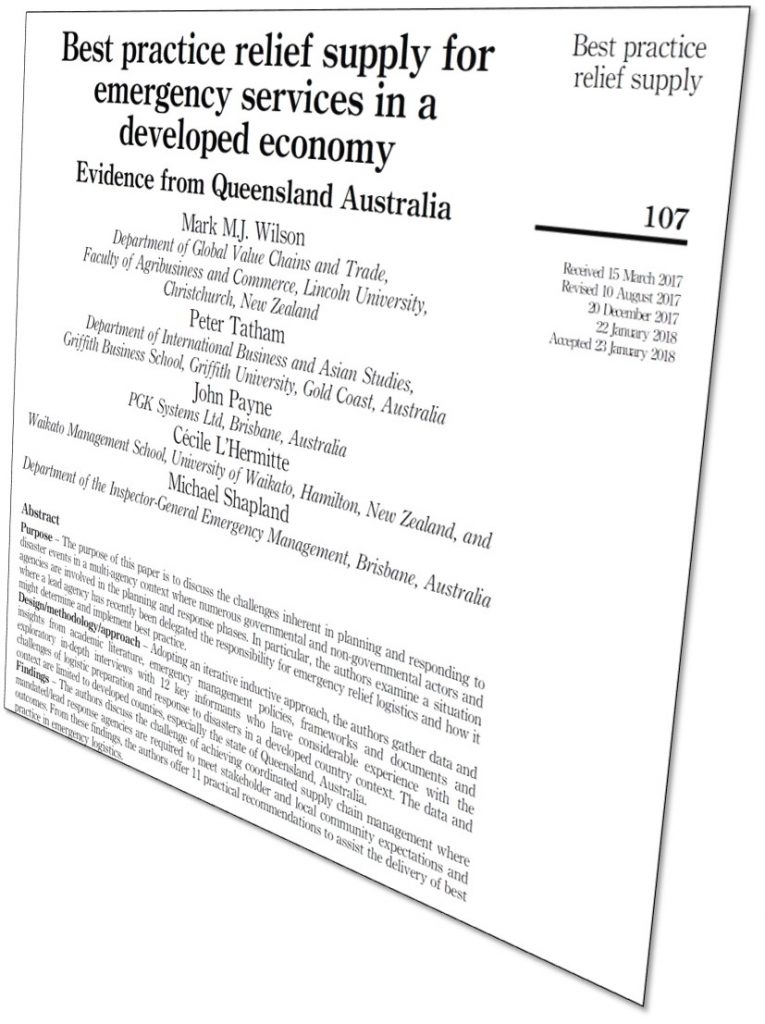
Lessons aren’t always from the past. There is much research being done in our universities which has direct relevant to you as disaster management practitioners.
In 2018 a team from New Zealand’s Lincoln University, Griffith University and Queensland’s Office of the Inspector General Emergency Management wrote a peer-reviewed paper in the Journal of Humanitarian Logistics and Supply Chain Management.
Entitled ‘Best practice relief supply for emergency services in a developed economy’, It produced a list of 11 practical recommendations to assist best practice in Emergency Management.
So let’s look at what it said. Here are my top ten.
Emergency supply is a science. Have a proper process and keep supporting documentation.
Well-defined processes, clearly documented, sequential and logical steps for the acquisition and provision of emergency supplies are the first step in getting your logistics right.
MCDEM, New Zealand (2017)
International Federation of Red Cross and Red Crescent Societies (IFRC) (2006)
World Food Programme (2015)
Consider how to best use stockpiling, warehousing and reverse supply chains to recover the stuff you’ve issued.
The pre-positioning of goods in anticipation of an emergency is a strategic decision and best practice in very large organisations, as is the recycling of relief supplies after the event. Generators communications equipment. Can you track them, have you a plan to recover and refurbish them? But remember; “the cost of maintaining great relationships is considerably less than the cost of maintaining stockpiles of goods in warehouses and generally achieves the desired outcomes better”.
FEMA (2017)
Peretti et al. (2015)
World Food Programme (2015)
Think about Resource integration and modularity – a logistics ‘Task Force’ approach.
The combination of resources (i.e. materiel, services and/or personnel) into flexible packages ready to be deployed gives you a ‘plug and play’ approach to improve response times and scalability.
International Federation of Red Cross and Red Crescent Societies (IFRC) (2016a)
World Food Programme (2015)
Advocate for Standardisation in emergency supply – an easy ‘pick list’ for tired minds and people.
A move towards standardisation for the procurement of emergency supplies, equipment, specifications and nomenclature across organisations will help accuracy in choosing what is needed. Accessible Standard catalogues are used by IFRC and UNHCR. Why not by us?
International Federation of Red Cross and Red Crescent Societies (IFRC) (2016b)
McGuire (2015), UNHCR (2017)
If you can’t ‘warehouse’ supplies, put in place Response framework agreements or Standing Offer Arrangements. They have risks but also benefits, too.
Fixed term and price “call-off” contracts with suppliers of emergency relief items thus simplifying procurement and shortening lead times. They do depend on suppliers to maintain their stock levels. But the know process and price will potentaily help both sides.
International Federation of Red Cross and Red Crescent Societies (IFRC) (2017)
Chen et al. (2013)
World Food Programme (2015)
Supplier management is critical if their support is going to work for you.
Consider if one of these three approaches is appropriate for the management of your key suppliers:
World Food Programme (2015)
Thomas and Kopczak (2005)
- Outsourcing – responsibility locked in with another agency,
- Relationship management – agile and responsive but reliant on relationships
- Active supplier management -with details, plans, contracts and costs giving accountability and governance.
Establish resource-sharing agreements – ‘There is no guarantee that every element of the emergency management organisation knows where all supplies and assets are in “peacetime”.
Disasters require a coordinated response. A pre planned requirement, therefore, is for resource-sharing arrangements or assets that allows visibility and flexibility across responding organisations, business and the local community. This is likely to be a continuing task.
Queensland Government (2017a)
Boin and t’Hart (2010)
UNHRD (2017b)
Fast track procurement – Have it in place and its funding agreed by all.
Establish prior approval to depart from usual procurement procedures in extreme situations – remembering that delegation and local procurement is often a faster route to supplies.
Queensland Government (2016)
World Food Programme (2015)
Have a centralised resource unit – AIIMS gives you this. Does your agency use it?
A centralised resource unit embedded within a coordination centre should act as a focal point for all procurement and logistics.
MCDEM, New Zealand (2017)
Rivera et al. (2013)
Think about cash transfer programmes as an alternative.
The replacement of physical relief supplies for cash payments to disaster victims allows individual needs to be met and works to build local economies.
World Food Programme (2015)
Norwegian Refugee Council (NRC in Jordan) (2015)